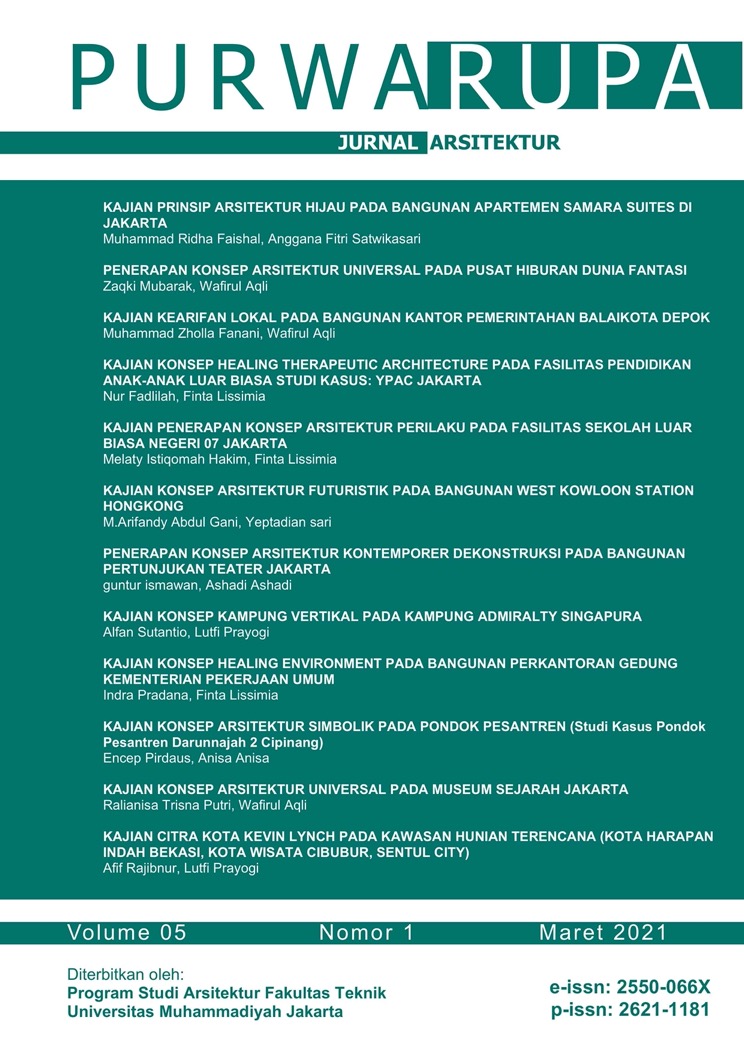KAJIAN KONSEP HEALING THERAPEUTIC ARCHITECTURE PADA FASILITAS PENDIDIKAN ANAK-ANAK LUAR BIASA STUDI KASUS: YPAC JAKARTA
DOI:
https://doi.org/10.24853/purwarupa.5.1.21-28Abstract
ABSTRAK. Anak-anak luar biasa adalah satu bagian dari masyarakat yang membutuhkan lingkungan yang didesain dengan konsep healing therapeutic tersebut karena keluarbiasaan yang mereka miliki dalam hal pemikiran, psikologis, dan interaksi sosial. Hal tersebut menuntut adanya fasilitas pendidikan yang memadai untuk meningkatkan potensi anak-anak luar biasa dan membantu mereka mengubah keluarbiasaan yang mereka miliki menjadi kepercayaan diri untuk menghasilkan karya-karya yang berguna bagi masyarakat. Berdasarkan latar belakang tersebut, penelitian ini berusaha mengkaji konsep healing therapeutic pada fasilitas pendidikan anak-anak luar biasa. Metode yang digunakan dalam penelitian ini adalah metode deskriptif kualitatif. Metode pengumpulan data dilakukan dengan menggunakan studi literatur dan observasi lapangan. Studi kasus yang diambil meliputi bangunan YPAC Jakarta. Analisis dilakukan dengan menggunakan pendekatan prinsip desain healing therapeutic (Chrysikou) dipadukan dengan prinsip media therapeutic (Holowitz), menghasilkan kajian bahwa: YPAC Jakarta menerapkan konsep healing therapeutic meliputi care in community, design fo domesticity, sosial valorization, integrated with nature, dan therapeutic media.akan tetapi belum sempurna dikarenakan prinsip material alami yang kurang memenuhi. Kata Kunci: healing, therapeutic, fasilitas, pendidikan, anak-anak luar biasa ABSTRACT. Extraordinary children are a part of society who need an environment designed with the concept of healing therapeutic because of the extraordinary they have in terms of thought, psychology, and social interactions. This requires adequate educational facilities to increase the potential of extraordinary children and help them turn their extraordinaryness into self-confidence to produce useful works for the community. Based on this background, this study seeks to examine the concept of healing therapeutic in educational facilities for special children. The method used in this research is descriptive qualitative method. The data collection method is done by using literature study and field observation. The case studies taken include the YPAC Jakarta building. The analysis was conducted using a healing therapeutic (Chrysikou) design principle approach combined with the principles of therapeutic media (Holowitz), resulting in a study that: YPAC Jakarta applies the concept of healing therapeutic including care in community, design for domesticity, social valorization, integrated with nature, and therapeutic media .will but not perfect due to the inadequate principle of natural materials.Keywords: healing, therapeutic, facilities, education, extraordinary childrenDownloads
Published
How to Cite
Issue
Section
License
COPYRIGHT POLICY
The author(s) of an article published in the Jurnal Teknologi retains ownership of the intellectual property rights in work (s).
PUBLISHING RIGHTS
The author(s) of an article published in the Jurnal Teknologi have unrestricted publication rights. The authors give the Jurnal Teknologi the right to publish the article and designate the Faculty of Engineering Universitas Muhammadiyah Jakarta Publishing as the original publisher of the article.
LICENSING POLICY
Journal of Mechanical Engineering and Sciences is an open-access journal that follows the Creative Commons Non-Commercial 4.0 International License (CC BY-NC 4.0), which states that:

Under this license, the reusers must give appropriate credit, provide a link to the license, and indicate if changes were made. Users may do so in any reasonable manner, but not in any way that suggests the licensor endorses users or their use.
Please take the time to read the whole license agreement (https://creativecommons.org/licenses/by-nc/4.0/). As long as reusers follow the license conditions, the owner cannot withdraw these freedoms. The following components are included under this license:
 Attribution: Users must provide appropriate attribution, including a link to the license, and indicate whether or not they made any modifications. Users are free to do so reasonably, but not in a manner that indicates the licensee approves of their usage.
Attribution: Users must provide appropriate attribution, including a link to the license, and indicate whether or not they made any modifications. Users are free to do so reasonably, but not in a manner that indicates the licensee approves of their usage.
 NonCommercial: Users may not use the material for commercial purposes.
NonCommercial: Users may not use the material for commercial purposes.

